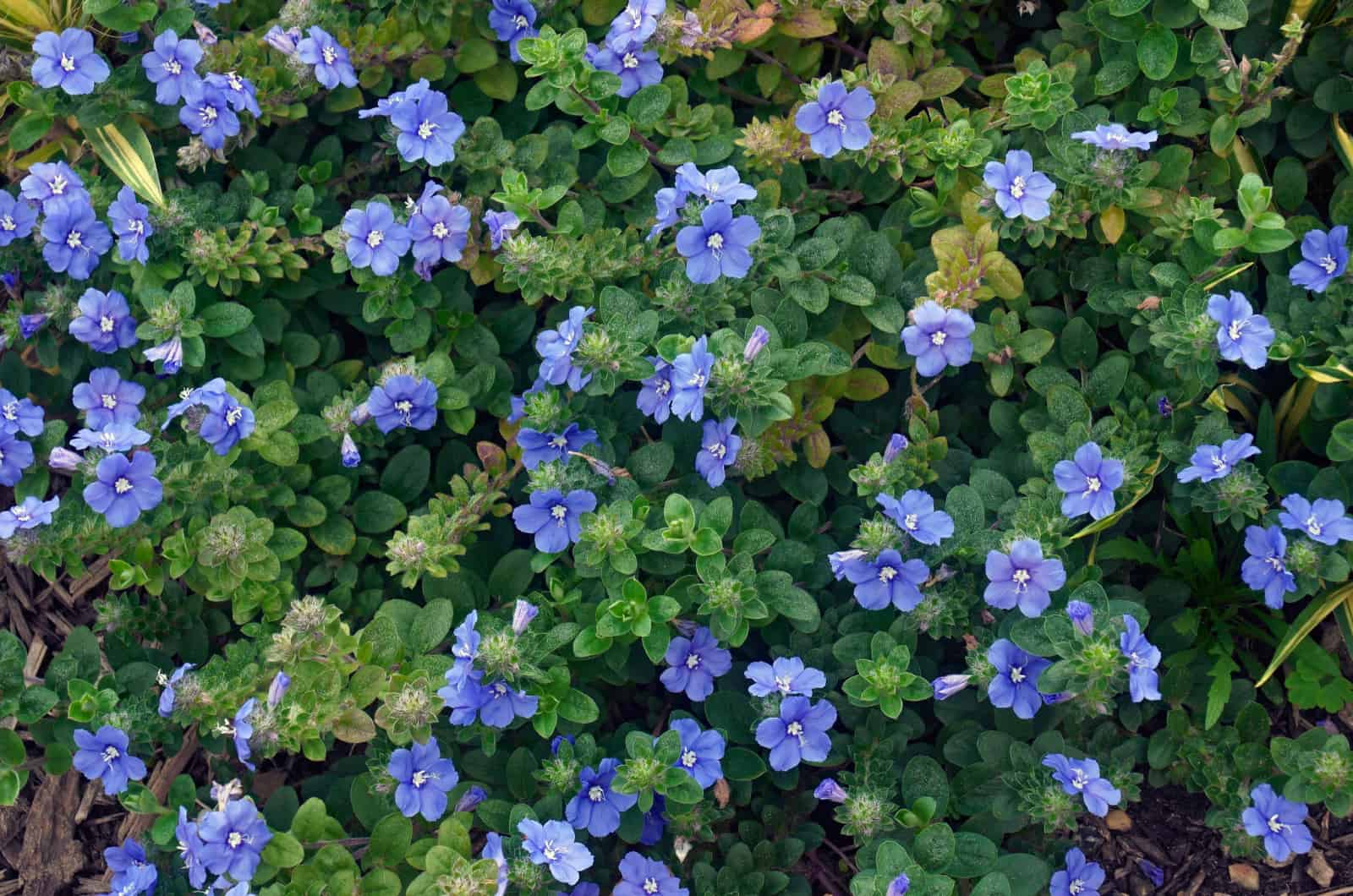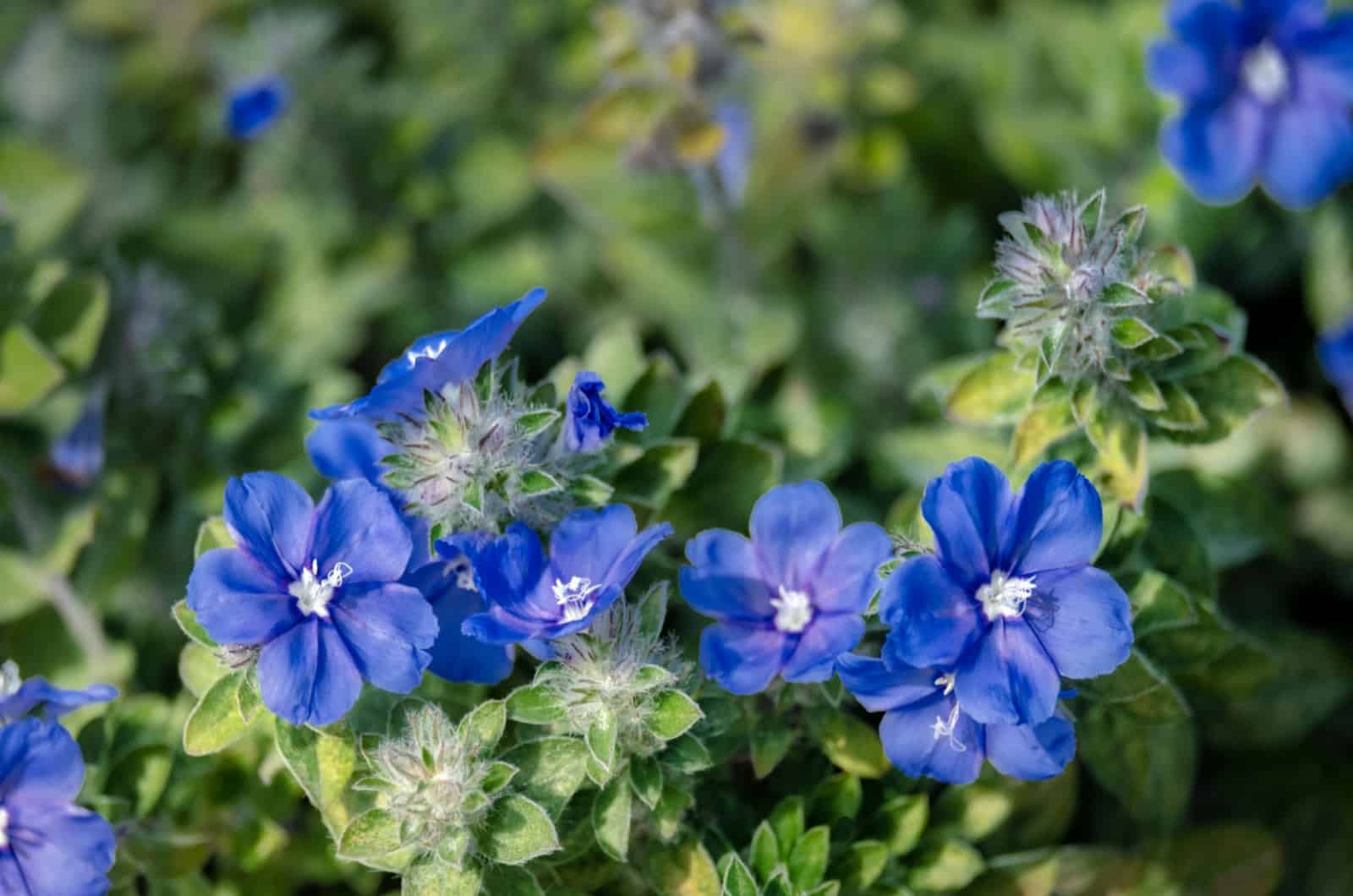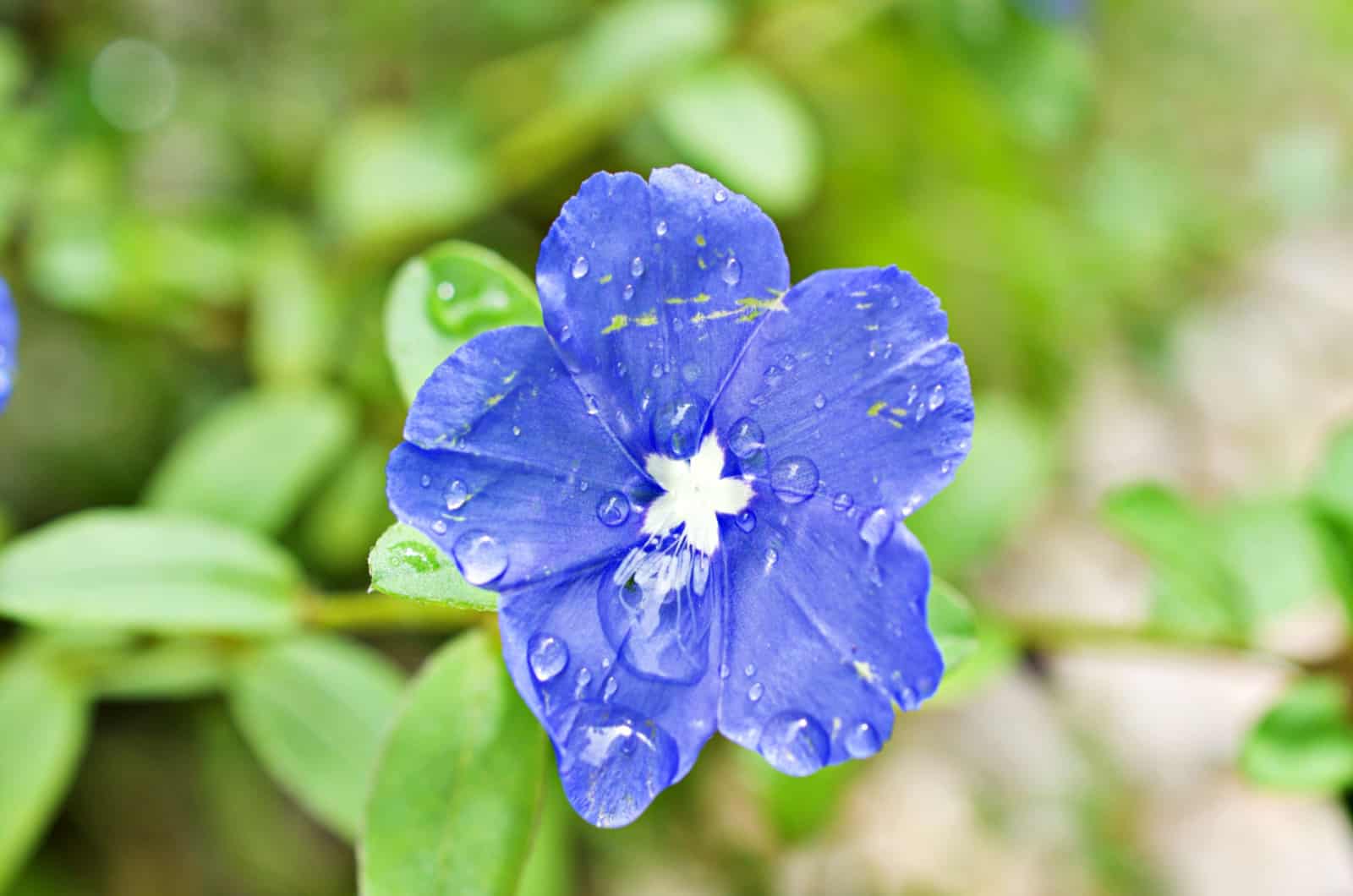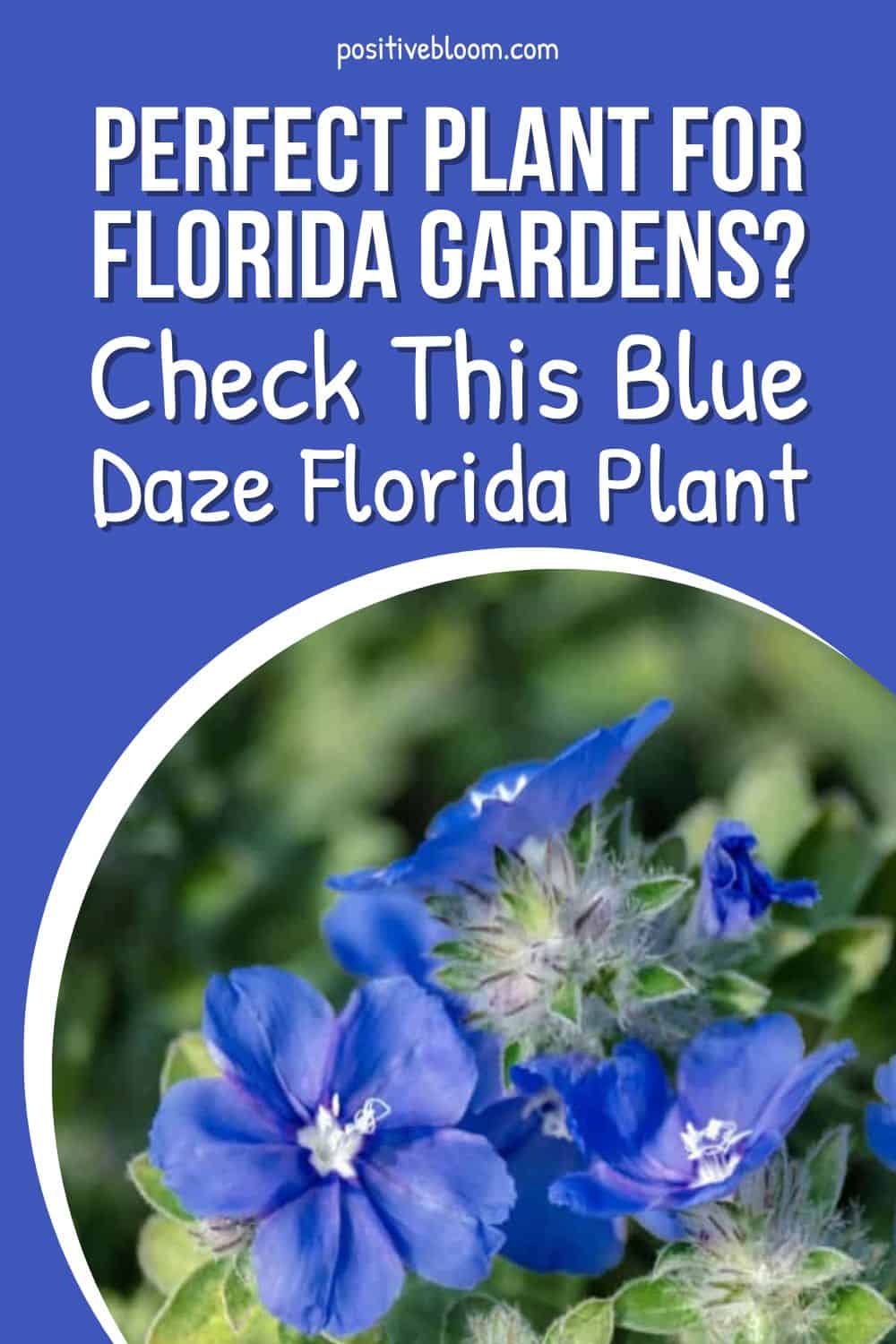Today we are going to talk about a plant that’s ideal for growing in Florida — surprising, right?
Growing plants in Florida can sometimes be a real nightmare because of the extreme weather conditions.
Blue daze, also known as Evolvulus glomeratus, is a perennial plant that blooms on and off throughout the year. This plant produces beautiful blue flowers that combine perfectly with silvery-green leaves in the background.
This hardy and pretty plant is usually grown for ornamental purposes, and sometimes even as ground cover in sunny areas of the garden!
Read on to learn more about Blue Daze Florida, how to take care of it, and loads more!
What Is Blue Daze Florida?
Here is some general information about Blue Daze:
[table id=225 /]
Blue Daze is the perfect plant to grow in Florida. Native to Paraguay and Brazil, this plant can grow in USDA hardiness zones 8 to 11.
It is an evergreen plant that produces funnel-shaped flowers with the most beautiful sky blue color. Blue Daze is a member of the morning glory family, which shares the specific characteristic of producing downy leaves, and they are collectively called Convolvulaceae.
This dense plant can grow up to 1 foot in height and can spread between 1 to 2 feet.
Blue Daze is a low-maintenance plant that can be propagated easily by stem cuttings or seeds. It is a fast-growing plant that is not considered invasive.
Blue Daze is also a drought-tolerant and low-growing plant, which is why it is commonly used as a ground cover — its magnificent blue flowers can create an ocean on the ground. It absolutely loves full sun exposure and can also thrive in partial shade, however, these sky-blue flowers may not be produced in abundance if the plant is constantly in the shade.
This plant is a perennial in South Florida and Central Florida, but it grows annually in North Florida where the winter season can get relatively cold — just check the USDA zones and make sure the plant is growing in the preferred range.
Not only is Blue Daze an excellent choice for Florida gardening, but it is also widely grown in Texas — it even has the nickname “Texas Superstar”!
Their green foliage with silvery shine makes the perfect background for those sky-blue flowers — the leaves are usually oval and they can grow about 2 inches long.
Another interesting thing about this plant is that its true blue flowers are short-lived, which means that they open early in the morning and die by the end of the day.
There is no doubt that these hardy plants can be used to create mesmerizing ground covers or make for great border plants, but they also look great in hanging baskets or as a spiller in mixed containers.
Due to their tolerance to salty conditions, these plants can thrive in coastal gardens as well!
How To Plant Blue Daze
The best time to plant Blue Daze is in spring so that the roots have enough time to establish once the summer arrives. During summer, the well-established roots are drought-tolerant and can survive hot temperatures and low watering.
Before you start planting, you have to prepare the soil. To do this, use a spade, hoe, or power tiller to break up the existing soil in the garden. Then add organic matter like compost or manure, and peat moss to loosen the soil.
These ingredients will contribute to the nutrient content of the soil and improve drainage, but also encourage microorganisms and earthworms to keep the soil healthy!
You could also give your plants a boost at the beginning of their growth stage by adding either granular starting fertilizer or balanced all-purpose fertilizer, such as 14 14 14.
Here is how to plant Blue Daze:
• Start by checking the plant label for suggested spacing. — As plants struggle for light, crowding them can cause fewer blooms and weaker growth. There may be exceptions to this rule, such as areas with a short growing season, shade plants that take longer to grow and fill in, or situations where it’s necessary to immediately cover a space with color, such as for a special event in your garden.
• Remove the plant from its container. — Gently squeeze the outside while tapping the container to help the plant come out. If the plant doesn’t come loose, keep applying pressure to the outside of the container while cautiously holding the plant’s base and pulling until it does.
Be careful not to damage or crush the stem while doing this. If the plant is in a pot, support the base, tip it to one side, then tap the outside of the container to help it come loose. Rotate the container while continuing to tap to break up the soil, and the plant should easily emerge from the pot.
• Dig a hole twice as large as the root ball. — It’s also important that you dig deep enough so that the plant is at the same level in the ground as it was in the container. Use your finger to gently rake the roots apart while holding the plant at the top of the root ball, and carefully put the plant in the hole.
• Fill the empty spaces around the root ball and gently press down the soil. — The soil surrounding the planting hole should be level with the soil around it or up to an inch higher than the top of the root ball. To ensure that new plantings have a strong foundation, they should be watered every day for a few weeks.
• You should provide a trellis, fence, or wall. — Vining annuals require some structure to grow and spread vigorously
We’ll now take a look at some Blue Daze varieties that are often used in landscape design.
Common Blue Daze Varieties
Did you know that there are almost 100 Evolvulus species?
That’s right, there are plenty of Blue Daze varieties, however, we are going to focus on the most common ones that you can use to decorate your garden.
Dwarf Morning Glory
Dwarf morning glory, also known as Evolvulus alsinoides, is your typical Blue Daze plant — it produces blue to lavender flowers and grows as an annual and perennial plant depending on the region.
This plant is hardy and can tolerate a lot of unfavorable conditions, such as high salinity concentration in the soil and full sun exposure. However, what it can’t tolerate is wet soil and poor air circulation.
It is sometimes hard to differentiate between Blue Daze varieties as they all look so similar, however, this means that in addition to having similar features they also have similar requirements, which makes caring for them much easier!
If you are interested in growing Blue Daze in your own garden, make sure to check out our plant care guide below.
Hawaiian Blue Eyes
Hawaiian Blue eyes, also known as Evolvulus glomeratus, is an annual plant that can bloom for the entire growing season. It is a low-maintenance plant that produces true blue flowers characteristic to Blue Daze varieties.
Here is some general information about the plant:
[table id=226 /]
I am sure that any of these varieties can be found in your local garden center, or you can easily find them online.
How To Take Care Of Blue Daze
As we already mentioned, it’s pretty easy to take care of a Blue Daze. Even if you skip a few watering sessions, it’s completely fine because this plant is drought tolerant and can survive without water for a long period of time.
All you have to do is provide them with the appropriate soil type and make sure they receive enough sunlight throughout the day.
You don’t have to worry about deadheading this plant because it’s self-cleaning. However, if you want to encourage new blooms and foliage growth, pruning and deadheading are your best options.
Let’s look at the basic requirements of your Blue Daze plant.
Soil Requirements
Blue Daze prefers growing in well-draining and sandy soil. Nutrient content is not as important because this plant can grow perfectly in poor soil, however, moisture retention and air circulation are crucial for good growth and development.
A loose potting soil that is also well-draining would be ideal!
Another thing that you should take into account when choosing soil for your Blue Daze plant is the pH level. These plants prefer acidic soil, though they can tolerate neutral pH levels.
Drainage is also crucial because an overwatered Blue Daze plant can easily wilt and die due to fungal infections caused by soggy soil. If you are growing your Blue Daze in a pot, make sure that it has drainage holes in the bottom.
Water Requirements
You will have to work a bit more if you are growing new baby Blue Daze plants. The new plantings require water on a daily basis for a couple of weeks, but once they’re established you can leave them without water for a longer period of time.
Ideally, these plants should be watered once or twice a week, though it depends on the variety (you can check the plant label for more info) and the placement of the plant in the garden.
For instance, if you keep your Blue Daze in a hotspot in your garden where it gets about 8 hours of direct sun on a day, the soil will dry out quickly and require more water.
If you keep the plant in partial shade, it will require less water.
Also take into consideration that clay soil retains moisture much longer than sandy soils, so you should also water it more frequently if you are growing the plant in sandy soils.
When it comes to methods of watering, I recommend you apply the water to the root zone around the base of the plant and avoid soaking the entire plant. For maintaining the health of plants and minimizing water loss through evaporation, a soaker hose is a wise purchase.
An excellent technique for managing irrigation is hand-watering using a watering can with a sprinkler head attached. Try to water in the morning if your garden is large and needs a sprinkler so that foliage can have time to dry during the day.
The reason we avoid watering the leaves is because wet leaves attract mold, pests, and various other fungi that can completely destroy your plant.
If you are wondering what the best water for plants is, make sure to check this article: What Is The Best Water For Plants? Find Out The Answer Here!
Light Requirements
We have already mentioned this a couple of times, but you must remember that Blue Daze plants absolutely love full sun exposure!
These plants need at least 6 to 8 hours of direct sunlight throughout the day, which is why they can be used as ground cover or planted in an area of your garden where most plants wouldn’t survive even for a day.
What’s also interesting is that these plants can also grow in partial shade, so if your sunny location gets a bit of shade during the day, it’s no biggie!
If you don’t provide these plants with appropriate light conditions, they might produce fewer flowers or none at all.
If you are growing them indoors for ornamental purposes (these flowers will make a great addition to your home), make sure that you put them near a window that gets direct sun exposure during the day.
Temperature & Humidity Requirements
It is important to keep the temperature above 60 degrees Fahrenheit for the Blue Daze plant to reach its full potential. However, some Blue Daze varieties can tolerate temperatures as low as 30 degrees Fahrenheit.
Growers that live in regions where the weather gets colder usually tend to add mulch around the base of the plant to keep it warm and aid with water retention.
They can thrive in coastal gardens and salty conditions, so they can grow perfectly well near the ocean. Humidity won’t be even an issue as they can adapt to various humidity levels!
Fertilizer Requirements
Blue Daze needs a little plant food to produce all those pretty sky-blue flowers!
Therefore, you should apply fertilizer at least once a month to encourage the growth and development of true blue flowers and silvery green foliage.
These plants don’t have a preference when it comes to the type of fertilizer either — you can use granular, slow-release, liquid, organic, or synthetic fertilizer, the choice is yours!
Slow-release fertilizers are applied at the beginning of the season, and release nutrients continuously into the soil. Granular fertilizers are usually applied monthly, while liquid fertilizers should be applied weekly.
Look for the perfect formula that can boost flower production — fertilizer for this plant must contain Nitrogen, Potassium, and Phosphorus.
Don’t fertilize your Blue Daze too much as it can lead to chemical build up in the soil. Overfertilization is a serious issue and can seriously damage your plant.
Pruning
How you prune your Blue Daze plant is completely up to you. If you want your plant to have a certain shape, keep pruning to maintain it and make your plant look nice and tidy.
If you are growing this plant in a hanging basket, then pruning isn’t strictly necessary — all you will have to do is remove any dead flowers.
However, an outdoor Blue Daze plant will need pruning once it starts growing quickly.
You can also prune the plant if it looks leggy, or has stopped growing — pruning will encourage new growth and seed production.
Keep the seeds if you want to propagate this plant!
Propagation
There are two methods to propagate this plant — either by sowing the seeds produced from a previous plant or by growing it from stem cuttings.
Sow the seeds indoors before the last frost date in sandy soil, and make sure to keep your new plants in a nice and warm place where they get plenty of sunlight!
For propagating by stem cuttings, choose a healthy stem from the parent plant and cut about 4 inches off it. Then plant it in a lightweight potting mixture like coarse or sand.
Once the temperature is warm enough, transplant your new plant outdoors and put it in a sunny location!
For more detailed information, check out this video:
Common Problems
Luckily, the Blue Daze plant isn’t susceptible to too many pests and diseases. The only issue is that overwatering the plant causes Pythium fungus.
Pythium is a soil-borne organism that favors high soil moisture. Contaminated soil, water, tools, and other implements can all transmit spores.
If the plant’s roots come into direct contact with the spores of this fungus, they will start to turn black and slowly decay. The infection will spread to the entire plant and completely destroy it.
You can get rid of the plant altogether to prevent spreading this deadly fungus, or you can apply fungicides such as copper fungicide or neem oil.
Frequently Asked Questions
1. Does Blue Daze grow in Florida?
Yes, Blue Daze is a plant that is perfect for growing in Florida gardens. This plant can tolerate various conditions, especially the hot Florida sun!
In fact, these plants adore direct sunlight and produce lots of flowers when they receive at least 6 hours of direct sunlight a day.
2. Is Blue Daze a flowering plant?
Blue Daze is all about flowers! This plant produces numerous sky-blue flowers that contrast the green foliage in the background perfectly.
This is a fast-growing plant that produces flowers all summer.
However, flowers might be scarce if the plant is grown in a shady area.
What’s also interesting is that these plants produce flowers early in the morning, and by the time the late afternoon comes they are already dead! But fear not because these flowers will be back again by the next morning!
3. What are the characteristics of Blue Daze?
Blue Daze is an evergreen plant that produces funnel-shaped flowers with the most beautiful sky blue color, which contrast the silvery green foliage in the background. This dense plant can grow 0.5 to 1 foot in height and can spread from 1 to 2 feet wide.
Because Blue Daze is a low-growing, drought-tolerant plant, it is frequently used as a ground cover because of its stunning blue blossoms.
Although it may survive in some shade, it prefers full sun. If the plant is consistently in shade, the production of it’s magnificent sky-blue blossoms may be reduced.
4. Is Blue Daze an annual or a perennial?
In most cases, the Blue Daze is a perennial plant. However, if the temperatures are significantly lower in a certain region (such as North Florida), then these plants grow annually.
In regions like Central or South Florida, these plants are perennial.
To Sum Up
The Blue Daze Florida plant is truly a work of art! This plant has almost no requirements, grows vigorously, and produces the prettiest flowers ever!
There are not many plants that can survive the crazy Florida weather and still thrive most of the time… yet, our little Blue Daze can do just that.
This plant is hardy and can tolerate a lot of unfavorable conditions, such as high salinity concentration in the soil and full sun exposure. However, it cannot tolerate wet soil and poor air circulation, which is why you must provide it with loose and well-draining soil.
As it can tolerate salty conditions, this plant is often used for decorating coastal gardens.
The sky-blue flowers truly bring calmness into gardens, and at the same time make the plant stand out from the rest with their pretty blue flowers.
I hope this article was helpful!
Until next time!
Like this post? Share or pin it for later!




